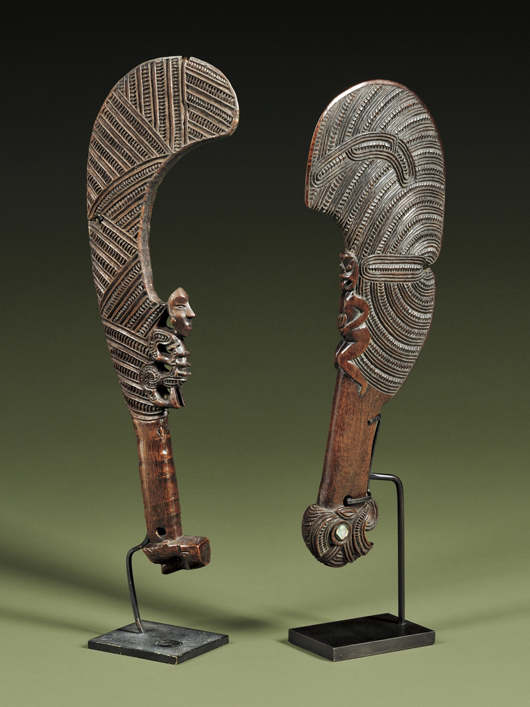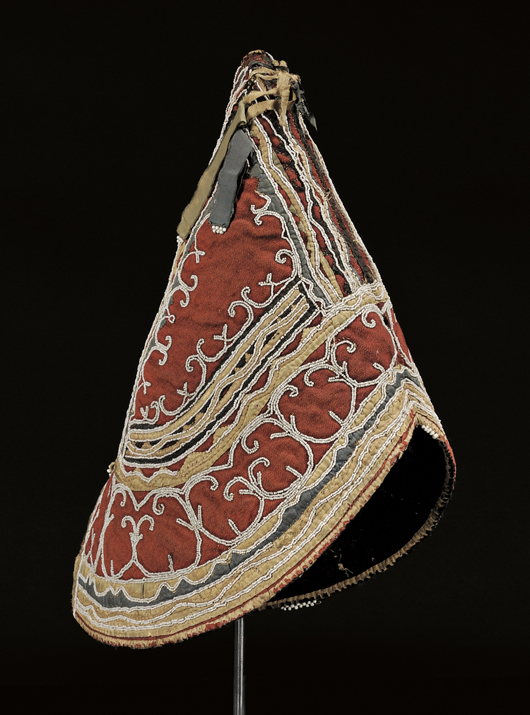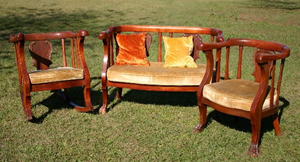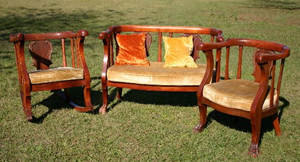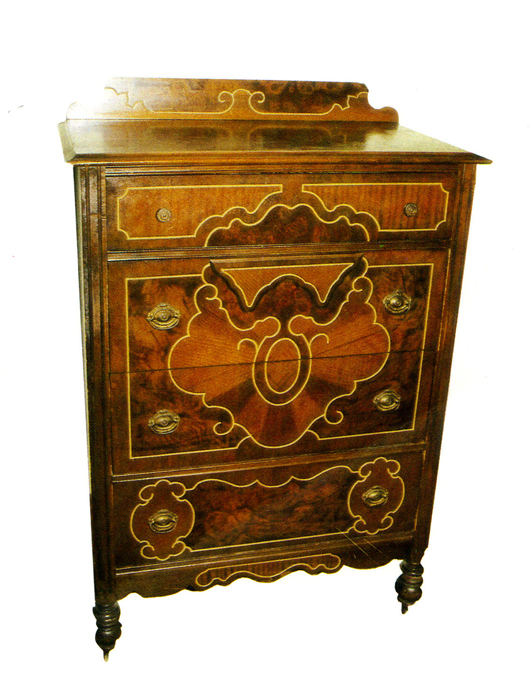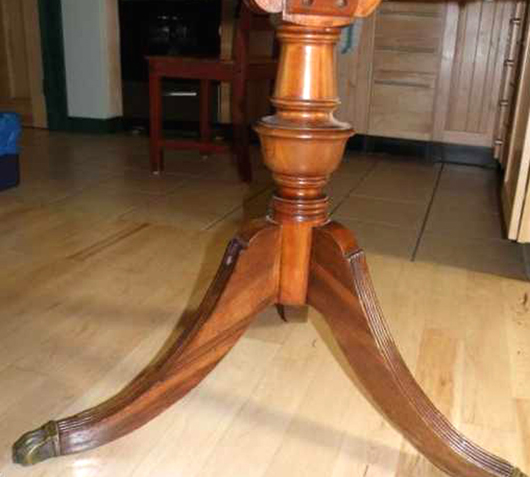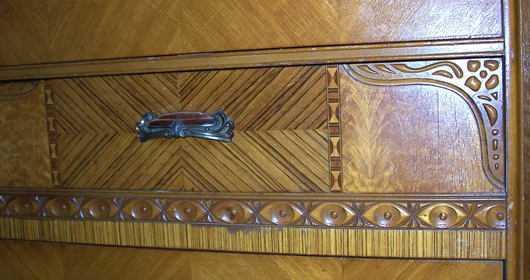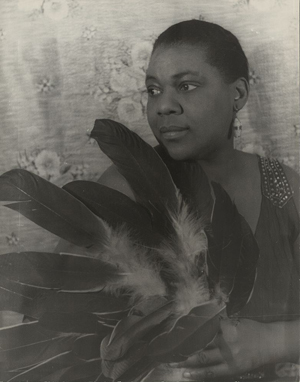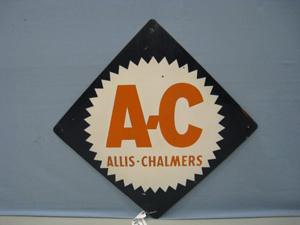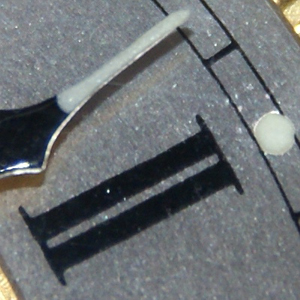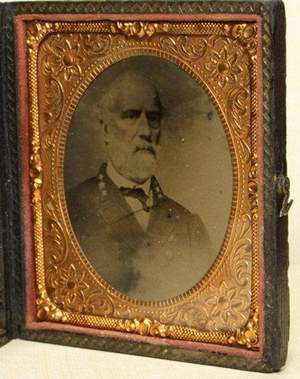
The Dr. Frank T. Siebert Collection
Perhaps the most exciting element of the sale is the collection from Dr. Frank T. Siebert Jr., a linguist and amateur anthropologist who collected over 350 Native American objects over his lifetime. This important collection, though including several fine Plains Indian items, emphasizes the East Coast, and especially the Penobscot area. Siebert acquired his collection mostly from friends and contacts in the villages he visited while working to document Algonquian languages. Highlighting the collection is a historic Penobscot peaked cap, lot 289, estimated at $40,000 to $60,000. This is one of only a handful of Penobscot women’s caps in existence, and most are in European or British museums. This particular cap is one of the nicest and earliest examples.
Other items from the Siebert collection include lot 276, a historic Bonaventure hatchet estimated at $8,000 to $12,000; a rare Wampum shell necklace, lot 277, valued at $20,000 to $30,000; a Northeast silver crown, lot 279, estimated at $10,000 to $15,000; a beaded cloth garter, circa late 18th/early 19th century, lot 284, estimated at $1,500 to $2,000; lot 286, a pair of man’s red stroud leggings, estimated at $8,000 to $12,000; and lot 287, a beaded cloth collar and cuffs, valued at $20,000 to $30,000.
Navajo Weavings
The sale is also graced with one of the best selections of Navajo weavings ever offered at a Skinner auction. Noteworthy lots include 504, a classic Mexican saltillo serape, estimated at $5,000 to $7,000, and 529, a Southwest pictorial weaving valued at $600 to $800. Excellent examples of third phase chief’s blankets include lot 533, estimated at $4,000 to $6,000; a Southwest weaving, lot 534, estimated at $8,000 to $12,000; another Southwest weaving from Lorenzo D. Creel and descended through his family, lot 537, estimated at $2,500 to $3,500; and a Germantown weaving, lot 539, valued at $3,000 to $5,000. Two classic second phase chief’s blankets are expected to fetch high prices: lot 542 from the collection of Mrs. Luke C. Walker is estimated at $100,000 to $150,000, and lot 544 is valued at $40,000 to $60,000.
American Plains Indian Material
Plains Indian material being offered includes many pair of moccasins such as lot 187, a pair of Apache beaded man’s moccasins estimated at $1,500 to $2,000 and an Oto pair, lot 188, valued at $6,000 to $8,000. Another highlight of the sale is an early pipe bag from the third quarter of the 19th century, lot 194, with an estimated auction value of $10,000 to $15,000. There are also several nice small pouches and cases; two model cradles, lots 219 and 220, estimated at $6,000 to $8,000 and $4,000 to $6,000, respectfully, with the latter coming from the ex-collection of Mary Dahl; a fine pictorial vest, lot 230, estimated at $3,000 to $5,000; and a beautiful Lakota women’s yoke, lot 237, valued at $8,000 to $12,000.
Northwest American Indian Art
Northwest Coast and Eskimo art is represented by several large totem poles coming from the collection of Paul and Joan Cluck such as lot 369, carved by Tony Hunt, estimated at $3,000 to $5,000; lot 370, attributed to Sam Williams, estimated at $5,000 to $7,000; lot 371, with various animal and avian totemic devices, estimated at $5,000 to $7,000; and lot 372, depicting a raven clan and valued at $10,000 to $15,000. Also from the region is a halibut hook, circa 1900, lot 382, estimated at $600 to $800; a fine sealskin drum, lot 384, estimated at $10,000 to $15,000; lot 385, a bentwood lidded box estimated at $15,000 to $20,000; a very nice child’s Chilkat blanket from the collection of Fred Boschan, lot 388, valued at $20,000 to $30,000; and an unusual European style carved chair, lot 389, valued at $8,000 to $12,000.
Southwest and Northeast American Indian Art
A large group of more than 35 Kachina dolls is to be offered from the Southwest, as well as a very good grouping of paintings highlighted by Sheldon Parson’s Pueblo scene, lot 431, estimated at $2,500 to $3,500, and lot 432, Fremont Ellis’ Spring in Santa Fe, estimated at $4,000 to $6,000. Also being offered are two works by Henry Balink, lot 437, Santiago, valued at $8,000 to $10,000, and lot 438, a portrait of Chief Yellow Bird, estimated at $20,000 to $30,000. Several Indian paintings from the 20th century will also be featured including two works by Tonita Pena titled Quah Ah, lots 440 and 441, estimated at $1,200 to $1,800 and $800 to $1,200, respectively. Quite a few Western photographic works are highlighted by lot 449, an Edward S. Curtis orotone entitled The Vanishing Race, with carries an auction value of $6,000 to $8,000.
Other beautiful Northeast material outside of the Siebert collection includes a pair of Penobscot beaded cloth and hide moccasins, lot 345, estimated at $3,000 to $4,000; a pair of Metis Cree quilled moccasins, lot 344, estimated at $7,000 to $9,000; a pair of Iroquois child’s moccasins, lot 345, valued at $4,000 to $6,000; and one of the finest Babiche bags in existence, lot 348, estimated at $12,000 to $16,000 and coming to Skinner from the ex-collection of Ed Jalbert and Fred Boschan.
American Indian Pottery
Finally, the auction features several wonderful lots of pottery, including some pre-historic items. Featured is a nice jar attributed to Nampeyo, lot 569, estimated at $4,000 to $6,000 and a large Southwest storage jar, Zia, circa last quarter 19th century, lot 574, estimated at $10,000 to $15,000. Works by Maria Martinez are represented by lot 560, a large San Ildefonso polished black bowl, estimated at $3,000 to $5,000; lot 566, a San Ildefonso black-on-black jar, estimated at $3,000 to $4,000; and lot 567, a Southwest black-on-black vase, coming to Skinner from the Chester College of New England and estimated at $1,500 to $2,000. A small but nice collection of basketry rounds out the sale with highlights including lot 593, a pomo coiled bowl, estimated at $3,000 to $4,000; lot 598, a California coiled bowl estimated at $2,500 to $3,500; and an Apache pictorial olla, lot 610, valued at $3,000 to $5,000.
African and Polynesian Art
The sale boasts a substantial, and often affordable, collection of African art and Polynesian material with some scarce items. Of note is lot 56, a Hemba figure from the collection of Joseph Aurelian Cornet, estimated at $4,000 to $6,000, and an interesting carved pillow, lot 57, estimated at $3,000 to $5,000. The sale offers many attractive African masks including lot 77, a nice antelope headdress estimated at $6,000 to $8,000; lot 88, a Kran mask valued at $1,200 to $1,600; an Ibo carved maiden mask, lot 99, estimated at $3,000 to $4,000; lot 102, a Lwalwa mask from the Democratic Republic of Congo with an auction estimate of $2,500 to $3,500; lot 106, a Bete, Ivory Coast mask valued at $6,000 to $8,000; and two Kifwebe masks, lots 108 and 109, both also from the Cornet collection, and estimated at $4,000 to $6,000 and $8,000 to $12,000, respectively.
Polynesian material being offered is highlighted by two pieces from the James Hooper collection, a British collector whose material is highly desirable. Lot 118 is a 19th century Maori chief’s staff estimated at $4,000 to $6,000 and lot 128 is a Marquesas Islands war club estimated at $60,000 to $80,000. Other featured items from the region include lot 116, a fine 19th century Maori treasure box estimated at $5,000 to $7,000; two Billhook hand clubs, lots 120 and 121, estimated at $3,000 to $4,000 and $6,000 to $8,000, respectively; and lot 122, a stilt step, estimated at $5,000 to $7,000.
Quite a bit of New Guinea material goes up for bid with a Melanesian wood spatula, lot 135, valued at $1,500 to $2,000, and a carved wood figure of Ramu, lot 137, estimated at $800 to $1,200, being of particular interest. Shields that are expected to be popular include a Dayak shield from the early 20th century, lot 156, valued at $1,500 to $2,000, and a Philippines shield from the same time, lot 157, estimated to sell for $800 to $1,200.
Previews for the auction will be Thursday, Sept. 22, noon to 5 p.m., Friday, Sept. 23, noon to 7 p.m., and Saturday, Sept. 24, 8 to 9:30 a.m. An illustrated printed catalog, #2563B, is available by mail for $35 ($42 for foreign requests) from the subscription department at 508-970-3000 x3240. It is also available at the gallery for $32.
For more information visit skinnerinc.com during and after the sale.
ADDITIONAL LOTS OF NOTE

